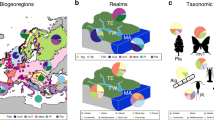Similar content being viewed by others
Main
Dolan doubts the lack of relation between phytoplankton diversity and zooplankton diversity in the world's oceans2. He argues that we compared apples with oranges, because our method to identify microzooplankton using simple morphological traits was limited to the genus level and hid microzooplankton diversity at the species level.
This argument applies not only to microzooplankton, but to many other taxonomic groups as well. Ecologists are often confronted with problems of species identity when estimating the diversity of organisms within poorly known groups. This is as true for studies of insects in tropical forests as it is for those of plankton in the oceans. Genetic studies of the taxonomy of small cyanobacteria3, of morphologically well established species of diatoms4, and of conspicuous organisms as large as the copepods5, have all revealed cryptic species. We therefore fully agree with Dolan that our simple methods will have underestimated the diversity at the species level.
However, our metrics would have been biased only if we had compared diversity data obtained by different methods (for example, morphological diversity for phytoplankton compared with genetic diversity for zooplankton). We disagree with Dolan's critique that we used two different measures of diversity. Instead, to avoid bias, our biodiversity estimates of phytoplankton and zooplankton were both based on exactly the same methodology, using only simple morphological traits.
We suggest that the lack of a positive correlation between plant diversity and herbivore diversity in the oceans is real, and can be explained by the broad diet of most marine herbivores. In contrast to many specialized terrestrial herbivores (many insects, for example), most zooplankton species do not rely on their food having a specific taxonomic composition. In terrestrial systems with a tight association between species (such as insects and their host plants), even taxonomic lumping of the sort criticized by Dolan is likely to reveal a positive correlation between plant diversity and herbivore diversity at the level of genus or family. Indeed, a seminal work on plant–insect co-evolution in terrestrial systems focuses on the family and genus level6.
Perhaps, then, the observed lack of a relationship was an artefact because we did not distinguish enough morphospecies among the microzooplankton? In which case, the alternative hypothesis of an increase in microzooplankton diversity with phytoplankton diversity would predict a decrease in the variance of microzooplankton diversity. However, we found that the variance in microzooplankton diversity was not related to phytoplankton diversity either. Inspection of our data reveals that the lack of a relationship may not be due to an underestimation of microzooplankton diversity, but rather to a relatively high microzooplankton diversity in oligotrophic regions with relatively low phytoplankton diversity. Likewise, a high copepod diversity has been found in oligotrophic areas of the Atlantic Ocean7.
The advance of molecular genetic techniques in oceanographic research may resolve the issue. Information on the genetic diversity of marine phytoplankton and zooplankton could confirm our findings2 and spur further research8 in this direction.
References
Dolan, J. Nature doi:10.1038/nature03320 (2005).
Irigoien, X., Huisman, J. & Harris, R. P. Nature 429, 863–867 (2004).
Janse, I., Meima, M., Kardinaal, W. E. A. & Zwart, G. Appl. Environ. Microbiol. 69, 6634–6643 (2003).
Orsini, L., Procaccini, G., Sarno, D. & Montresor, M. Mar. Ecol. Prog. Ser. 271, 87–98 (2004).
Goetze, E. Proc. R. Soc. Lond. B 270, 2321–2331 (2003).
Ehrlich, P. R. & Raven, P. H. Evolution 18, 586–608 (1964).
Woodd-Walker, R. S., Ward, P. & Clarke, A. Mar. Ecol. Prog. Ser. 236, 189–203 (2002).
Census of Marine Life (http://www.coml.org).
Author information
Authors and Affiliations
Corresponding author
Rights and permissions
About this article
Cite this article
Irigoien, X., Huisman, J. & Harris, R. Different measures of biodiversity (Reply). Nature 433, E9 (2005). https://doi.org/10.1038/nature03321
Published:
Issue Date:
DOI: https://doi.org/10.1038/nature03321
Comments
By submitting a comment you agree to abide by our Terms and Community Guidelines. If you find something abusive or that does not comply with our terms or guidelines please flag it as inappropriate.



